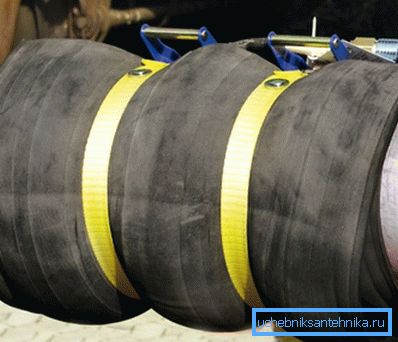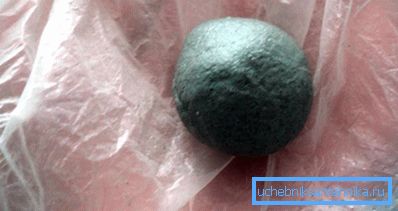How to glue the plastic pipe
In modern communications plastic pipes are increasingly used, especially for domestic needs. Sewerage, plumbing and heating systems for the most part consist of polypropylene pipes or PVC products. Such popularity is due to the long service life, ease of installation and reliability of polymer pipes. But such products are sometimes in need of repair. This article will talk about how to glue the plastic pipe.
What to do first when a leak occurs

If a leak in the high-pressure pipes, the heating system or other communications, appeared in the apartment or house, the first thing to do is to shut off the valves. This truth is familiar to all. But what to do next?

Emerging leakage can be “plugged” with clamps. Such designs are simply put on the desired area and tightened with bolts.

You can use the old way - use rubber. This method is often repaired pipe heating or plumbing. The problem area is wrapped with a piece of rubber (for example, from car tires) and clamped with a yoke or overtightened with a thin wire or durable cord.
Tip! You can use regular paint. The place of the appearance of cracks or leaks is wrapped with a cloth and painted with oil paint.
But all of the above methods can be considered a temporary solution. If such patches are left for a long time, then the flow will appear again. That is why many masters recommend replacing the problem area, especially since it is quite easy to do this using plastic pipes.
Sealant and epoxy adhesive

The causes of cracks or leaks on plastic pipes can be many. This may be a violation of the rules of installation, improper operation or simple marriage during production. If the crack is small, then you can not carry out the replacement, and try to glue the pipe.
The first way to carry out repairs is to use silicone sealant. This method is suitable when the crack is not through. As a rule, this method is used in the repair of sewer pipes. The course of work will be as follows:
- The crack is cleared and, if possible, widens. It is necessary that the sealant penetrates as deeply as possible.
- Next, you need to degrease and dry the place of repair work.
- Then a layer of sealant is applied and allowed to dry.

And how to repair a through hole, for example, in the same sewer pipe? In this case, it is better to use a two-component epoxy adhesive. Works are performed in the following sequence:
- The area with a crack is cleaned, degreased and dried.
- Then we prepare a suitable bandage. A piece of fiberglass or other dense and flexible material is best suited for this.
- The repaired area along the entire length of the crack with a margin is wrapped with a bandage, while the number of revolutions must be at least five.
- The final step will be applying a layer of epoxy glue.
This method is quite suitable as in the case of repair of pipes for sewage, and for water (for example, for a towel warmer).
We use sealing tape

One of the modern ways of eliminating small leaks of pipes in a bathroom or toilet can be considered the use of sealing tape. This material is an adhesive fabric with a special impregnation. As a rule, sealing tape is used at joints and at joints, but it is also suitable for straight sections.
Progress will be as follows:
- The repaired pipe section is cleared of contaminants and dried.
- Stretch a small piece of tape and begin to wind it over the pipe. At the same time, the material must be constantly kept under tension in order to prevent the appearance of folds.
- When winding you need to lay the next section of the tape on half the previous one. As a result, your pipe will be “packed” in two layers of sealing material.
Tip! This method has one drawback. Sealing tape does not tolerate sunlight. Therefore, the repaired area must be covered with a protective layer.
We use cold welding

Today, in specialized stores you can find a special, so-called dry cold welding. Its composition is designed specifically for the repair of plastic pipes intended for plumbing, cooling systems, heating or other needs.
Cold welding can reliably seal up almost any crack or leak. There is no need for heating, the components of the material are brought to the desired state as a result of a chemical reaction.
Progress in repairing a leak or repairing a crack will look like this:
- First prepare the surface. The entire problem area is treated with emery cloth. Then the surface should be degreased (it is better to do this with liquids containing alcohol). This procedure is mandatory, otherwise the lifetime of the “patch” will be minimal.
- Then we determine the amount of material needed. This is done by eye, as long as the resulting mass is enough to cover the entire problem area.
- The material is taken in hand (while they should be wearing wet rubber gloves) and wrinkled to the finished state. Readiness will be reported by the color of the mass, it should turn brown. At the same time the material reaches the consistency of clay;
- The mass is applied to the desired area and pressed with a tow. After that, the pipe does not touch for an hour. After removing the harness, cold welding turns into a solid and dense substance that can be drilled, cut and perform any other actions.
Tip! When working with cold welding it is important to observe precautions. The composition includes substances harmful to the body, so you need to work with gloves and goggles.
To speed up the work, you can use tricks from the experts. For example, cold welding hardens better when exposed to warm air. If you want to quickly complete the repair work, you can use a building or regular hairdryer.
Modern manufacturers offer to purchase cold welding, with which you can repair plumbing devices. Today, sticking a broken piece of a sink or toilet bowl is not a problem. The main thing when making the purchase of cold welding is to familiarize yourself with the label. Check the shelf life of the material, its composition (it should contain epoxy and amine resins, as well as steel and mineral filler), and also ask about the quality certificate.